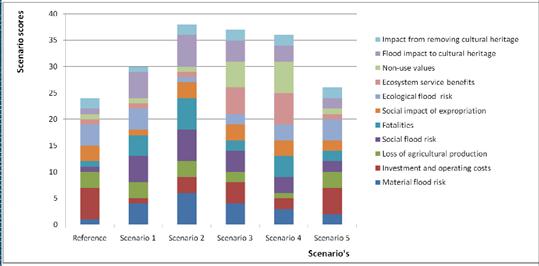Post a comment on the text below
Box 5.6 Impact of flooding on human health, ecology, cultural heritage and economic activity
The Floods Directive (EC 2007c, Art. 1) states its purpose as “to establish a framework for the assessment and management of flood risks, aiming at the reduction of the adverse consequences for human health, the environment, cultural heritage and economic activity associated with floods in the Community”. In the Floodresiliencity different techniques of mapping and combining the different categories of negative consequences are tried for the Dijle catchment (Belgium) at the city of Leuven and upstream.
The most important economic receptors were material damages to houses, building and industries, infrastructure and cars together with agricultural damages. Social and health impacts were evaluated by a proxy using number of affected people together with a score based on their exposure, susceptibility and adaptation capacities. Cultural heritage was evaluated counting the architectural relics and entities in the medieval city, the monuments and especially world cultural heritage by UNESCO. The ecological impacts were mainly upstream of the city and were based on a combination of vulnerability and biological values (see figure 5.2).
Figure 5.2 Ecological impacts of flooding in the Dijle catchment upstream of Leuven

Source: VMM 2011 and CIS WG Floods Workshop on Floods and Economics, Ghent, 25-16/10/2010
A cost-benefit analysis and multi-criteria analysis with criteria for all 4 types of negative consequences were applied on the different scenarios of measures. A basic result can be found in figure 5.3 but the final ranking are depending on the stakeholders involvement, their visions and their weights.
Figure 5.3 Score of the different scenarios of measures in the MCA analysis for the Dijle around Leuven

Source: VMM 2011 and CIS WG Floods Workshop on Floods and Economics, Ghent, 25-16/10/2010
Note: reference = actual situation including already decided measures, scenario 1 = flood conveyance (infrastructure works in the city), scenario 2 = flood storage concentrated in nature areas upstream, scenario 3 = flood storage distributed in the valley, scenario 4 = further upstream flood storage in Wallonia, scenario 5 = non-structural measures (prevention, flood forecasting, resilience measures and improved assistance)
Source: VMM 2011, FloodResilienCity (www.floodresiliencity.eu), http://whc.unesco.org
You cannot post comments to this consultation because you are not authenticated. Please log in.



Previous comments
what is the main message of box 5.6? should the title not reflect the fact that it was a case study?